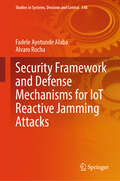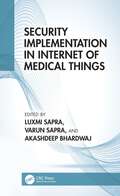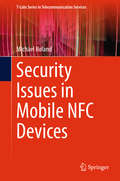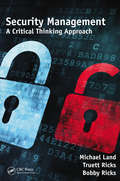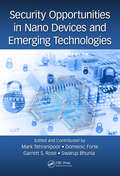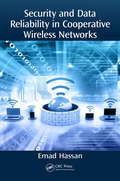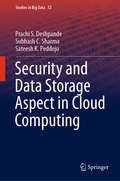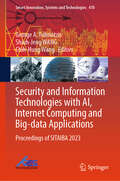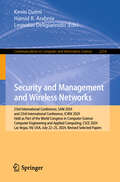- Table View
- List View
Security Framework and Defense Mechanisms for IoT Reactive Jamming Attacks (Studies in Systems, Decision and Control #548)
by Alvaro Rocha Fadele Ayotunde AlabaThis book digs into the important confluence of cybersecurity and big data, providing insights into the ever-changing environment of cyber threats and solutions to protect these enormous databases. In the modern digital era, large amounts of data have evolved into the vital organs of businesses, providing the impetus for decision-making, creativity, and a competitive edge. Cyberattacks pose a persistent danger to this important resource since they can result in data breaches, financial losses, and harm to an organization's brand. Features of particular interest include: a. Understanding the Threat Landscape: The book gives a complete review of the many different types of cyber threats that target big data, including data breaches, ransomware attacks, and insider threats. b. Analysing Real-World Case Studies: The purpose of this section is to provide the reader with useful insights into the strategies, methods, and processes that cyber adversaries use via the in-depth examination of real-world assaults on big data. c. Strategies for Risk Mitigation: This book provides a comprehensive and actionable approach to reducing the dangers of cyberattacks on large amounts of data. It encompasses a broad variety of tactics, including network protection, encoding, and access restrictions d. Emerging Technologies: This section introduces readers to cutting-edge technologies and best practices for securing large data. e. Compliance with Regulations: The book examines the regulatory environment that governs data protection and privacy, including the General Data Protection Regulation (GDPR), the California Consumer Privacy Act (CCPA), and industry-specific requirements. f. Trends of the Future: This book covers current trends and issues in cybersecurity and gives forward-looking views into the future of big data security. This is done in recognition that the cybersecurity environment is always shifting and developing. g. Contributors of Expertise: The book includes contributions from industry practitioners, data scientists, and cybersecurity specialists who have hands-on experience defending large data settings.
Security Framework for The Internet of Things Applications (Computational Methods for Industrial Applications)
by Quan Z. Sheng Wei Emma Zhang Salma Abdalla HamadThe text highlights a comprehensive survey that focuses on all security aspects and challenges facing the Internet of Things systems, including outsourcing techniques for partial computations on edge or cloud while presenting case studies to map security challenges. It further covers three security aspects including Internet of Things device identification and authentication, network traffic intrusion detection, and executable malware files detection.This book: Presents a security framework model design named Behavioral Network Traffic Identification and Novelty Anomaly Detection for the IoT Infrastructures Highlights recent advancements in machine learning, deep learning, and networking standards to boost Internet of Things security Builds a near real-time solution for identifying Internet of Things devices connecting to a network using their network traffic traces and providing them with sufficient access privileges Develops a robust framework for detecting IoT anomalous network traffic Covers an anti-malware solution for detecting malware targeting embedded devices It will serve as an ideal text for senior undergraduate and graduate students, and professionals in the fields of electrical engineering, electronics and communication engineering, computer engineering, and information technology.
Security Implementation in Internet of Medical Things
by Akashdeep Bhardwaj Varun Sapra Luxmi SapraSecurity implementation is crucial in the Internet of Medical Things (IoMT) as it ensures the protection of sensitive medical data and prevents unauthorized access to or manipulation of devices and systems. This book covers different aspects of security implementations and challenges in IoMT and aims to bring researchers together to contribute their findings to recommend new methodologies and feasible solutions for implementing security and novel architectures in artificial intelligence, machine learning, and data science in the field of healthcare and IoT. IoMT includes a wide range of connected medical devices and systems, such as wearable devices, medical sensors, and electronic health records, that collect, store, and share sensitive medical information. Without proper security measures, this information could be compromised, leading to serious privacy breaches, financial fraud, and even physical harm to patients.
Security Incidents & Response Against Cyber Attacks (EAI/Springer Innovations in Communication and Computing)
by Akashdeep Bhardwaj Varun SapraThis book provides use case scenarios of machine learning, artificial intelligence, and real-time domains to supplement cyber security operations and proactively predict attacks and preempt cyber incidents. The authors discuss cybersecurity incident planning, starting from a draft response plan, to assigning responsibilities, to use of external experts, to equipping organization teams to address incidents, to preparing communication strategy and cyber insurance. They also discuss classifications and methods to detect cybersecurity incidents, how to organize the incident response team, how to conduct situational awareness, how to contain and eradicate incidents, and how to cleanup and recover. The book shares real-world experiences and knowledge from authors from academia and industry.
Security Issues and Privacy Threats in Smart Ubiquitous Computing (Studies in Systems, Decision and Control #341)
by Aboul Ella Hassanien Nilanjan Dey Parikshit N. Mahalle Gitanjali R. ShindeThis book extends the work from introduction of ubiquitous computing, to the Internet of things to security and to privacy aspects of ubiquitous computing. The uniqueness of this book is the combination of important fields like the Internet of things and ubiquitous computing. It assumes that the readers’ goal is to achieve a complete understanding of IoT, smart computing, security issues, challenges and possible solutions. It is not oriented towards any specific use cases and security issues; privacy threats in ubiquitous computing problems are discussed across various domains. This book is motivating to address privacy threats in new inventions for a wide range of stakeholders like layman to educated users, villages to metros and national to global levels. This book contains numerous examples, case studies, technical descriptions, scenarios, procedures, algorithms and protocols. The main endeavour of this book is threat analysis and activity modelling of attacks in order to give an actual view of the ubiquitous computing applications. The unique approach will help readers for a better understanding.
Security Issues for Wireless Sensor Networks
by Ankur Dumka Alaknanda Ashok Parag Verma Anuj Bhardwaj Navneet Kaur Anil Kumar Bisht Raksh Pal GangwarWireless sensor networks (WSNs) have attracted high interest over the last few decades in the wireless and mobile computing research community. Applications of WSNs are numerous and growing, including indoor deployment scenarios in the home and office to outdoor deployment in an adversary’s territory in a tactical background. However, due to their distributed nature and deployment in remote areas, these networks are vulnerable to numerous security threats that can adversely affect their performance. This problem is more critical if the network is deployed for some mission-critical applications, such as in a tactical battlefield. Random failure of nodes is also very likely in real-life deployment scenarios. Due to resource constraints in the sensor nodes, a traditional security mechanism with high overhead of computation and communication is not feasible in WSNs. Design and implementation of secure WSNs is, therefore, a particularly challenging task. This book covers a comprehensive discussion on state-of-the-art security technologies for WSNs. It identifies various possible attacks at different layers of the communication protocol stack in a typical WSN and presents their possible countermeasures. A brief discussion on the future direction of research in WSN security is also included.
Security Issues in Fog Computing from 5G to 6G: Architectures, Applications and Solutions (Internet of Things)
by Chintan Bhatt Yulei Wu Massimo Villari Saad HarousThe book provides an examination of how fog security is changing the information technology industry and will continue to in the next decade. The authors first discuss how fog enables key applications in wireless 5G, the Internet of Things, and big data. The book then presents an overview of fog/edge computing, focusing on its relationship with cloud technology, Internet of Things and the future with the use of secure 5G/6G communication. The book also presents a comprehensive overview of liabilities in fog/edge computing within multi-level architectures and the intelligent management. The last part of the book reviews applications of fog/edge computing in smart cities, including in Industrial IoT, edge-based augmented reality, data streaming, and blockchain-based.
Security Issues in Mobile NFC Devices
by Michael RolandThis work provides an assessment of the current state of near field communication (NFC) security, it reports on new attack scenarios, and offers concepts and solutions to overcome any unresolved issues. The work describes application-specific security aspects of NFC based on exemplary use-case scenarios and uses these to focus on the interaction with NFC tags and on card emulation. The current security architectures of NFC-enabled cellular phones are evaluated with regard to the identified security aspects.
Security Management for Industrial Safety Critical Applications: A Practical Approach (Asset Analytics)
by Lalit Kumar Singh Pooja Singh Raj Kamal Kaur Ajit K. VermaThe book introduces dependability (security metric) ideas, gives a general overview of the security analysis of Safety-Critical Systems (SCSs), explains why the study is necessary and defines key terms relevant to this research. It makes an effort to emphasize the significance of security in comparison to other dependability indicators and illustrates the key drivers of this research's purpose. The mathematical foundation of the security analysis process is briefly illustrated, and key mathematical terminology and concepts are presented that are crucial for the security evaluation of critical systems. This book's objective is to provide a thorough understanding of the security analysis process. It will be a research-focused book designed for undergraduate, graduate, and doctoral courses in software and cyber security. The fundamentals of reliability, security, metrics, and mathematical foundation have been covered in this book. Each technique's actual applications, along with benefits and drawbacks, are also shown. Applying each technique to the various case studies serves as a demonstration of how it works. By using the many case studies of safety-critical systems, the students can also learn different analysis approaches and how to model them. Students will be able to use these tools, in particular, on a case study of their choice to analyze system security. The book includes a comparison of various strategies and appropriate recommendations for further reading on these subjects. Moreover, this book's target audience includes software professionals who are interested in security analysis.
Security Management for Occupational Safety (Occupational Safety & Health Guide Series #15)
by Michael LandHow far would or should you go to feel secure? While everyone wants safety and security, the measures to achieve it are often viewed of as intrusive, unwanted, a hassle, and limiting to personal and professional freedoms. Yet, when an incident occurs, we can never have enough security. Security Management for Occupational Safety provides a framewor
Security Management: A Critical Thinking Approach
by Michael Land Truett Ricks Bobby RicksSecurity is a paradox. It is often viewed as intrusive, unwanted, a hassle, or something that limits personal, if not professional, freedoms. However, if we need security, we often feel as if we can never have enough. Security Management: A Critical Thinking Approach provides security professionals with the ability to critically examine their organ
Security Manager's Guide to Disasters: Managing Through Emergencies, Violence, and Other Workplace Threats
by Anthony D. ManleyTerrorist or criminal attack, fire emergency, civil or geographic disruption, or major electrical failure recent years have witnessed an increase in the number of natural disasters and man-made events that have threatened the livelihoods of businesses and organizations worldwide. Security Manager‘s Guide to Disasters: Managing Through Emergencies,
Security Opportunities in Nano Devices and Emerging Technologies
by Mark Tehranipoor, Domenic Forte, Garrett S. Rose and Swarup BhuniaThe research community lacks both the capability to explain the effectiveness of existing techniques and the metrics to predict the security properties and vulnerabilities of the next generation of nano-devices and systems. This book provides in-depth viewpoints on security issues and explains how nano devices and their unique properties can address the opportunities and challenges of the security community, manufacturers, system integrators, and end users. This book elevates security as a fundamental design parameter, transforming the way new nano-devices are developed. Part 1 focuses on nano devices and building security primitives. Part 2 focuses on emerging technologies and integrations.
Security Policy in System-on-Chip Designs: Specification, Implementation and Verification
by Sandip Ray Swarup Bhunia Abhishek BasakThis book offers readers comprehensive coverage of security policy specification using new policy languages, implementation of security policies in Systems-on-Chip (SoC) designs – current industrial practice, as well as emerging approaches to architecting SoC security policies and security policy verification. The authors focus on a promising security architecture for implementing security policies, which satisfies the goals of flexibility, verification, and upgradability from the ground up, including a plug-and-play hardware block in which all policy implementations are enclosed. Using this architecture, they discuss the ramifications of designing SoC security policies, including effects on non-functional properties (power/performance), debug, validation, and upgrade. The authors also describe a systematic approach for “hardware patching”, i.e., upgrading hardware implementations of security requirements safely, reliably, and securely in the field, meeting a critical need for diverse Internet of Things (IoT) devices.Provides comprehensive coverage of SoC security requirements, security policies, languages, and security architecture for current and emerging computing devices;Explodes myths and ambiguities in SoC security policy implementations, and provide a rigorous treatment of the subject;Demonstrates a rigorous, step-by-step approach to developing a diversity of SoC security policies;Introduces a rigorous, disciplined approach to “hardware patching”, i.e., secure technique for updating hardware functionality of computing devices in-field;Includes discussion of current and emerging approaches for security policy verification.
Security Rights in Intellectual Property (Ius Comparatum - Global Studies in Comparative Law #45)
by Eva-Maria KieningerThis book discusses the main legal and economic challenges to the creation and enforcement of security rights in intellectual property and explores possible avenues of reform, such as more specific rules for security in IP rights and better coordination between intellectual property law and secured transactions law. In the context of business financing, intellectual property rights are still only reluctantly used as collateral, and on a small scale. If they are used at all, it is mostly done in the form of a floating charge or some other “all-asset” security right. The only sector in which security rights in intellectual property play a major role, at least in some jurisdictions, is the financing of movies. On the other hand, it is virtually undisputed that security rights in intellectual property could be economically valuable, or even crucial, for small and medium-sized enterprises – especially for start-ups, which are often very innovative and creative, but have limited access to corporate financing and must rely on capital markets (securitization, capital market). Therefore, they need to secure bank loans, yet lack their own traditional collateral, such as land.
Security Trends for FPGAS
by Jean Luc Danger Benoit Badrignans Guy Gogniat Viktor Fischer Lionel TorresIn Security Trends for FPGA's the authors present an analysis of current threats against embedded systems and especially FPGAs. They discuss about requirements according to the FIPS standard in order to build a secure system. This point is of paramount importance as it guarantees the level of security of a system. Also highlighted are current vulnerabilities of FPGAs at all the levels of the security pyramid. It is essential from a design point of view to be aware of all the levels in order to provide a comprehensive solution. The strength of a system is defined by its weakest point; there is no reason to enhance other protection means, if the weakest point remains untreated. Many severe attacks have considered this weakness in order not to face brute force attack complexity. Several solutions are proposed in Security Trends for FPGA's especially at the logical, architecture and system levels in order to provide a global solution.
Security and Data Reliability in Cooperative Wireless Networks
by Emad HassanFollowing a detailed overview of cooperative communications and the physical layer security, this book proposes relay and jammer selection schemes for security in one-way cooperative networks and to improve physical layer security in two-way cooperative networks. It also proposes a Cooperative Hybrid Self-Healing scheme to enhance the confidentiality of the data collected by UWSN. It ends with a proposal called Self-Healing Cluster Controlled Mobility (SH-CCM) scheme based on hybrid cooperation between both Proactive and Reactive peers and the sick sensors at both network and cluster levels to guarantee the security in UWSN.
Security and Data Storage Aspect in Cloud Computing (Studies in Big Data #52)
by Prachi S. Deshpande Subhash C. Sharma Sateesh K. PeddojuThis book analyses the various security threats in cloud computing. A host-based IDS (HIDS) using signature verification is developed and implemented for the concerned security issues. Further, owing to the vulnerability of distributed denial of service (DDoS) attacks in cloud computing, a network based IDS (NIDS) is developed and implemented against such attacks. The performance of these IDS is verified in the Cloud scenario as well against the standard data set. Finally, a simple data storage and security model is developed and implemented for the Cloud computing scenario. The contents of this book will be of interest to researchers and professionals alike.
Security and Defence in Europe (Advanced Sciences and Technologies for Security Applications)
by J. Martín Ramírez Jerzy BiziewskiThis book argues that security and defense have never been true priorities in the European Union, and have constantly been marginalized by the elites since the Soviet Union collapsed and the Warsaw Pact disintegrated. Despite the official rhetoric, only a few tangible results can be presented concerning the operational readiness of European forces, and the EU’s inability to act was proven during the crises in the Balkans, NATO has experienced similar problems, as the majority of its members are EU countries. Both organizations have declared their resolve concerning the security and defense of their nations and territories, but, unfortunately, little has been done to lend these statements credence. In this context, the book analyzes several aspects of EU security and defense, including: the EU – NATO relationship, common defense policy and strategy, common capability building, common understanding of strategic changes, common operational planning and centrally synchronized exercises based on operational planning, etc. The member states have helped to make EU/NATO effective organizations, but unfortunately their individual interests and priorities constitute real challenges. This aspect should be discussed and addressed by political and military elites, scholars, analysts, students and the general public alike.
Security and Defence: Ethical and Legal Challenges in the Face of Current Conflicts (Advanced Sciences and Technologies for Security Applications)
by Juan Cayón PeñaThis book aspires to face the challenge of analyzing with due academic rigor, always in the paradigm of security and advanced sciences, but without forgetting the ethical questions that our world raises every day. The work is divided into two main sections: the first section is focused on the cyber world, with not only technical but also legal derivations given the expansion of vulnerabilities and our technological dependence. The second section, with a more interdisciplinary nature, runs through undeniably topical issues such as territorial problems and the potential decline of the traditional States, the communicational impact of information management and false news, or the commitment to essential freedoms for the West. This book connects advanced technologies and ethical issues and includes discussions on recent crises such as COVID-19. It also provides an interdisciplinary view on the ethical issues for security technologies.
Security and Fault Tolerance in Internet of Things (Internet of Things)
by Rajat Subhra Chakraborty Athanasios V. Vasilakos Jimson MathewThis book covers various aspects of security, privacy and reliability in Internet of Things (IoT) and Cyber-Physical System design, analysis and testing. In particular, various established theories and practices both from academia and industry are presented and suitably organized targeting students, engineers and researchers. Fifteen leading academicians and practitioners wrote this book, pointing to the open problems and biggest challenges on which research in the near future will be focused.
Security and Information Technologies with AI, Internet Computing and Big-data Applications: Proceedings of SITAIBA 2023 (Smart Innovation, Systems and Technologies #410)
by George A. Tsihrintzis Shiuh-Jeng Wang Chih-Hung WangThe book presents selected papers from Second International Conference on Security and Information Technologies with AI, Internet Computing and Big-Data Applications (SITAIBA 2023), held at Chihlee University of Technology, New Taipei City during 7 – 9 December 2023. This book presents current research in information security, AI and deep learning applications, information processing, cyber-security and evidence investigations, and information hiding and cryptography.
Security and Management and Wireless Networks: 23rd International Conference, SAM 2024 and 23rd International Conference, ICWN 2024, Held as Part of the World Congress in Computer Science, Computer Engineering and Applied Computing, CSCE 2024, Las Vegas, NV, USA, July 22–25, 2024, Revised Selected Papers (Communications in Computer and Information Science #2254)
by Hamid R. Arabnia Kevin Daimi Leonidas DeligiannidisThis book constitutes the proceedings of the 23rd International Conference on Security and Management, SAM 2024, and the 23rd International Conference on Wireless Networks, ICWN 2024, held as part of the 2024 World Congress in Computer Science, Computer Engineering and Applied Computing, in Las Vegas, USA, during July 22 to July 25, 2024. For SAM 2024, 255 submissions have been received and 40 papers have been accepted for publication in these proceedings; the 12 papers included from IWCN 2024 have been carefully reviewed and selected from 66 submissions. They have been organized in topical sections as follows: Intrusion and attack detection: malware, malicious URL, phishing; security assessment and management + blockchain + use of artificial intelligence; cybersecurity and communications systems + cryptography and privacy; security and management + new methodologies and applications; wireless networks and mobile computing.
Security and Privacy Applications for Smart City Development (Studies in Systems, Decision and Control #308)
by Aboul-Ella Hassanien Nilanjan Dey Sharvari Chandrashekhar TamaneThis book explores the fundamentals of smart cities along with issues, controversies, problems and applications concerning security and privacy in smart city development. Future smart cities must incorporate innovations like smart rainwater harvesting, smart street lighting, digital identity management, solar energy, intelligent transport systems and emerging communication applications. The target audience of the book includes professionals, researchers, academics, advanced-level students, technology developers, doctors and biologists working in the field of smart city applications. Professionals will find innovative ideas for marketing and research, while developers can use various technologies like IoTand block chain to develop the applications discussed here. As the book shows, by integrating new technologies, the cities of the future are becoming a reality today.
Security and Privacy Preserving for IoT and 5G Networks: Techniques, Challenges, and New Directions (Studies in Big Data #95)
by Wojciech Mazurczyk Brij B. Gupta Ahmed A. Abd El-Latif Bassem Abd-El-Atty Salvador E. Venegas-AndracaThis book presents state-of-the-art research on security and privacy- preserving for IoT and 5G networks and applications. The accepted book chapters covered many themes, including traceability and tamper detection in IoT enabled waste management networks, secure Healthcare IoT Systems, data transfer accomplished by trustworthy nodes in cognitive radio, DDoS Attack Detection in Vehicular Ad-hoc Network (VANET) for 5G Networks, Mobile Edge-Cloud Computing, biometric authentication systems for IoT applications, and many other applications It aspires to provide a relevant reference for students, researchers, engineers, and professionals working in this particular area or those interested in grasping its diverse facets and exploring the latest advances on security and privacy- preserving for IoT and 5G networks.
